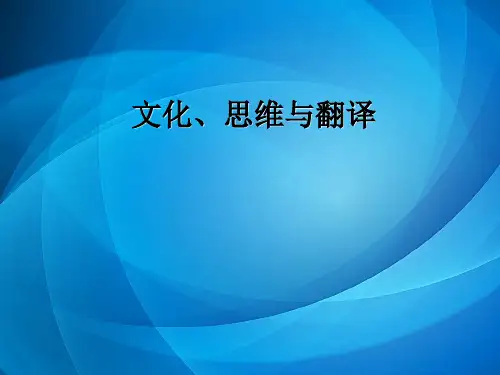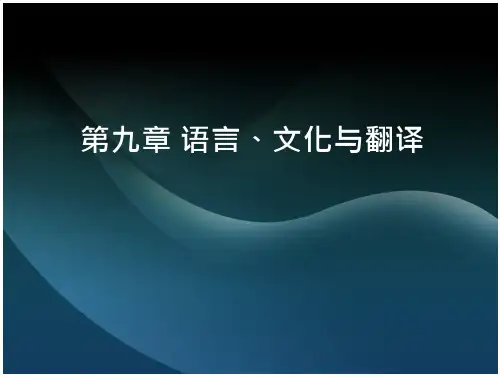第九章 英汉文化与翻译
- 格式:ppt
- 大小:170.00 KB
- 文档页数:12
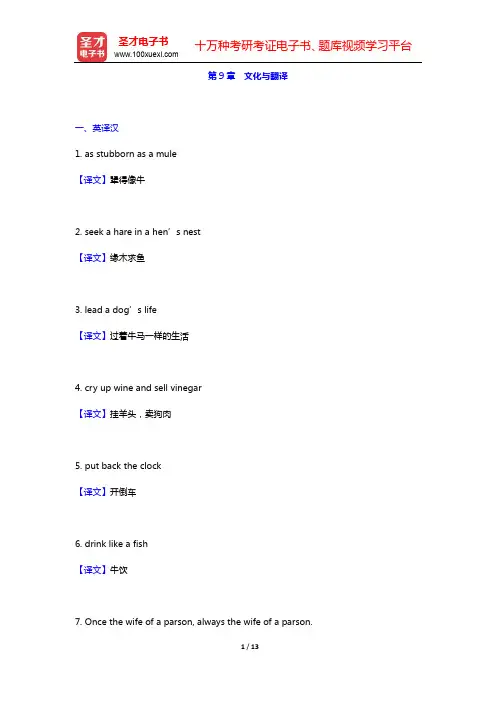
第9章文化与翻译一、英译汉1. as stubborn as a mule【译文】犟得像牛2. seek a hare in a hen’s nest【译文】缘木求鱼3. lead a dog’s life【译文】过着牛马一样的生活4. cry up wine and sell vinegar【译文】挂羊头,卖狗肉5. put back the clock【译文】开倒车6. drink like a fish【译文】牛饮7. Once the wife of a parson, always the wife of a parson.【译文】嫁鸡随鸡,嫁狗随狗。
8. —“Until her husband won the pools, she was the most commonplace, dowdy, illiterate creature imaginable, but now that she dresses herself up like a society queen and nearly always remembers to sound her aitches, people are already beginning to forget what she was like before.”—“Fine feathers make fine birds.”【译文】——“过去没有比她更平平常常、无知无识而又邋邋遢遢的了,自从她男人赢得全部赌注以后,她打扮得象个社交皇后,总是记住发H的音,人们开始忘记她以前是什么样子了。
”——“人靠衣裳马靠鞍嘛。
”9. I’d much rather see her once or twice and not do anything about it---what could I do about it anyway? She’s a bit out of my class, don’t you think? If I did try to do anything, I’d only get sent off with a flea in my ear.【译文】我宁愿见她一两面就算了──我还能干什么呢?你没看到她和我不怎么相称吗?我要干点什么,也只会碰一鼻子灰。
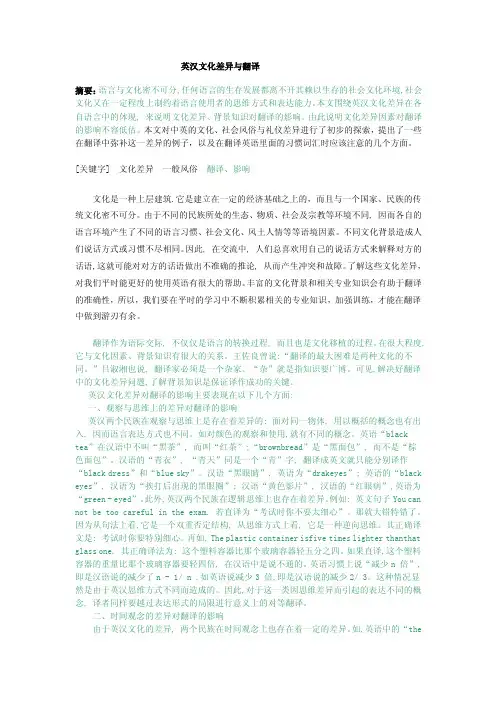
英汉文化差异与翻译摘要:语言与文化密不可分,任何语言的生存发展都离不开其赖以生存的社会文化环境,社会文化又在一定程度上制约着语言使用者的思维方式和表达能力。
本文围绕英汉文化差异在各自语言中的体现, 来说明文化差异、背景知识对翻译的影响。
由此说明文化差异因素对翻译的影响不容低估。
本文对中英的文化、社会风俗与礼仪差异进行了初步的探索,提出了一些在翻译中弥补这一差异的例子,以及在翻译英语里面的习惯词汇时应该注意的几个方面。
[关键字] 文化差异一般风俗翻译、影响文化是一种上层建筑.它是建立在一定的经济基础之上的,而且与一个国家、民族的传统文化密不可分。
由于不同的民族所处的生态、物质、社会及宗教等环境不同, 因而各自的语言环境产生了不同的语言习惯、社会文化、风土人情等等语境因素。
不同文化背景造成人们说话方式或习惯不尽相同。
因此, 在交流中, 人们总喜欢用自己的说话方式来解释对方的话语,这就可能对对方的话语做出不准确的推论, 从而产生冲突和故障。
了解这些文化差异,对我们平时能更好的使用英语有很大的帮助。
丰富的文化背景和相关专业知识会有助于翻译的准确性,所以,我们要在平时的学习中不断积累相关的专业知识,加强训练,才能在翻译中做到游刃有余。
翻译作为语际交际, 不仅仅是语言的转换过程, 而且也是文化移植的过程。
在很大程度, 它与文化因素、背景知识有很大的关系。
王佐良曾说:“翻译的最大困难是两种文化的不同。
”吕淑湘也说, 翻译家必须是一个杂家。
“杂”就是指知识要广博。
可见,解决好翻译中的文化差异问题,了解背景知识是保证译作成功的关键。
英汉文化差异对翻译的影响主要表现在以下几个方面:一、观察与思维上的差异对翻译的影响英汉两个民族在观察与思维上是存在着差异的: 面对同一物体, 用以概括的概念也有出入, 因而语言表达方式也不同。
如对颜色的观察和使用,就有不同的概念。
英语“black tea”在汉语中不叫“黑茶”, 而叫“红茶”;“brownbread”是“黑面包”, 而不是“棕色面包”。
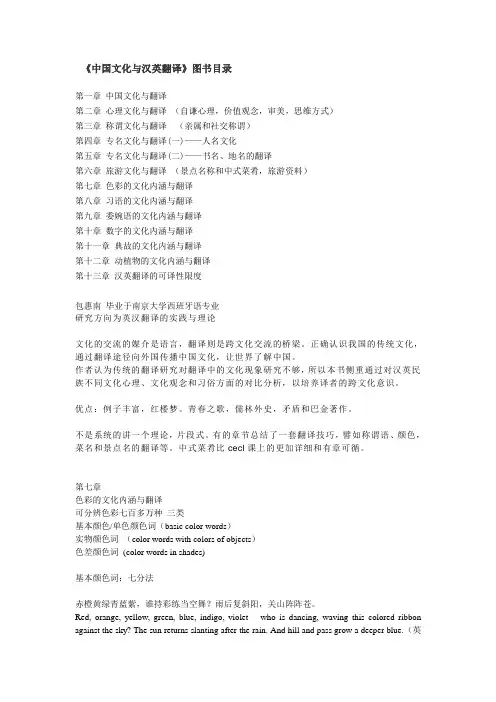
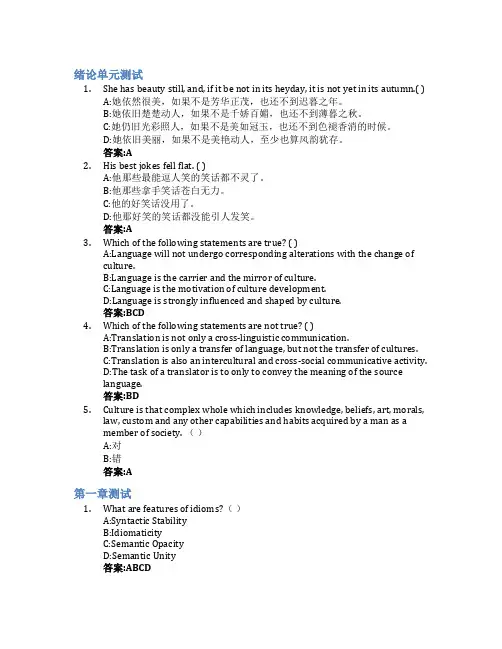
绪论单元测试1.She has beauty still, and, if it be not in its heyday, it is not yet in its autumn.( )A:她依然很美,如果不是芳华正茂,也还不到迟暮之年。
B:她依旧楚楚动人,如果不是千娇百媚,也还不到薄暮之秋。
C:她仍旧光彩照人,如果不是美如冠玉,也还不到色褪香消的时候。
D:她依旧美丽,如果不是美艳动人,至少也算风韵犹存。
答案:A2.His best jokes fell flat. ( )A:他那些最能逗人笑的笑话都不灵了。
B:他那些拿手笑话苍白无力。
C:他的好笑话没用了。
D:他那好笑的笑话都没能引人发笑。
答案:A3.Which of the following statements are true? ( )A:Language will not undergo corresponding alterations with the change ofculture.B:Language is the carrier and the mirror of culture.C:Language is the motivation of culture development.D:Language is strongly influenced and shaped by culture.答案:BCD4.Which of the following statements are not true? ( )A:Translation is not only a cross-linguistic communication.B:Translation is only a transfer of language, but not the transfer of cultures.C:Translation is also an intercultural and cross-social communicative activity.D:The task of a translator is to only to convey the meaning of the sourcelanguage.答案:BD5.Culture is that complex whole which includes knowledge, beliefs, art, morals,law, custom and any other capabilities and habits acquired by a man as amember of society. ()A:对B:错答案:A第一章测试1.What are features of idioms?()A:Syntactic StabilityB:IdiomaticityC:Semantic OpacityD:Semantic Unity答案:ABCD2.Semantic Opacity refers to the extensive usage of idiomatic expressionsamong people. ()A:对B:错答案:B3.Literal translation could retain the images in the target language and belongsto foreignization.()A:错B:对答案:B4.What is the translation me thod for“have other fish to dry 另有公干”()A:TransliterationB:Literal Translation Plus AnnotationsC:Literal TranslationD:Liberal Translation答案:D5.What is the translation method for “四面楚歌to be besieged on all sides(“楚”is the name of a stateduring the period of Warring States)”?()A:Literal Translation Plus AnnotationsB:Liberal TranslationC:Literal TranslationD:Transliteration答案:A第二章测试1.Onomatopoeia is the formation or use of () such as buzz or murmur thatimitate the sounds associated with the objects or actions they refer to.A:soundsB:wordsC:actionsD:characters答案:B2.The part of speech of English onomatopoeia is noun or verb, which works as().A:predicateB:objectC:the subjectD:attributive答案:ABC3.In translating the sentence ”There were no soun d but that of the tread of themen and the footsteps of the two shaggy ponies which drew the van.” whattranslation technique is employed in the translated version: “那时候只听见沙沙的脚步声以及拉车的那两匹鬃毛蓬松的小马得得的马蹄声,除此之外,再也听不到别的声音了。
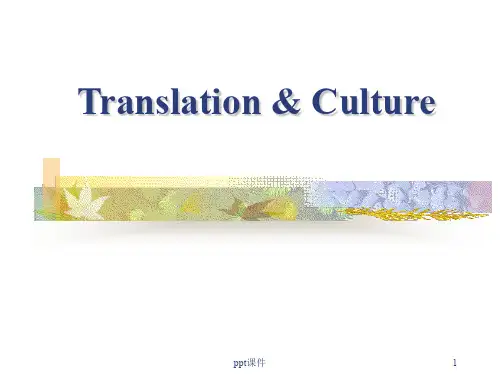
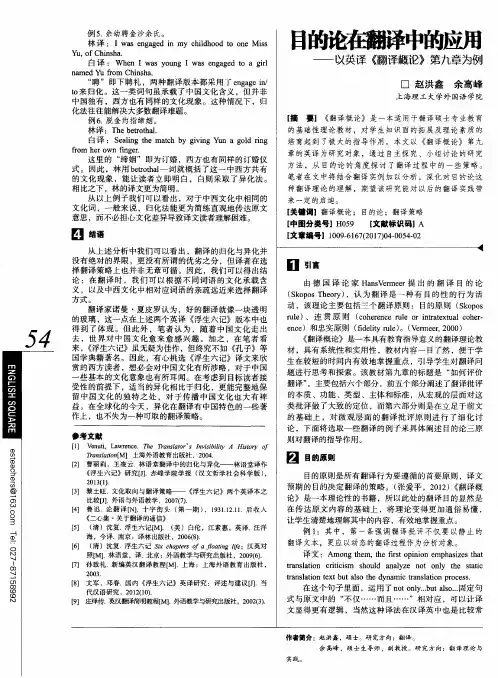
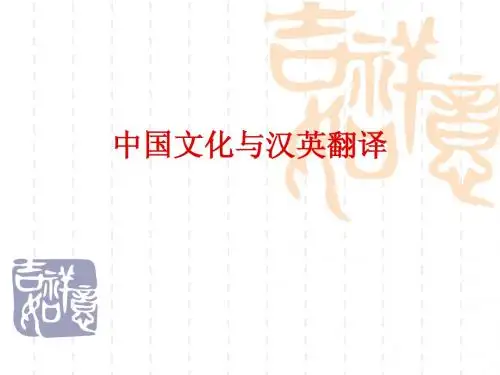
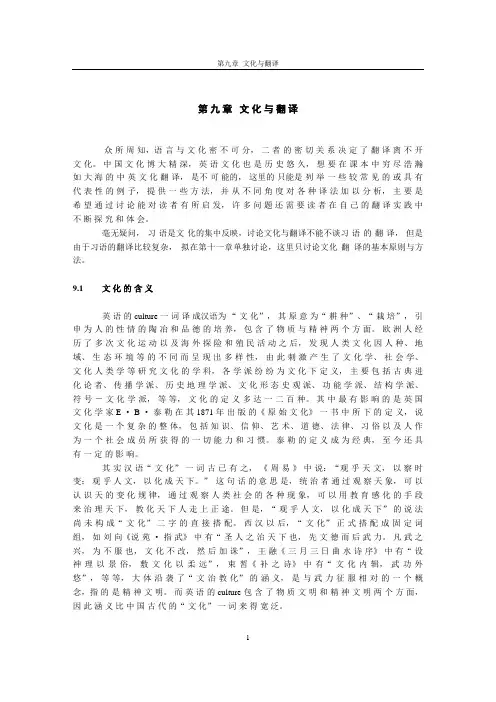
第九章文化与翻译第九章文化与翻译众所周知,语言与文化密不可分,二者的密切关系决定了翻译离不开文化。
中国文化博大精深,英语文化也是历史悠久,想要在课本中穷尽浩瀚如大海的中英文化翻译,是不可能的,这里的只能是列举一些较常见的或具有代表性的例子,提供一些方法,并从不同角度对各种译法加以分析,主要是希望通过讨论能对读者有所启发,许多问题还需要读者在自己的翻译实践中不断探究和体会。
毫无疑问,习语是文化的集中反映,讨论文化与翻译不能不谈习语的翻译,但是由于习语的翻译比较复杂,拟在第十一章单独讨论,这里只讨论文化翻译的基本原则与方法。
9.1 文化的含义英语的 culture 一词译成汉语为“文化”,其原意为“耕种”、“栽培”,引申为人的性情的陶冶和品德的培养,包含了物质与精神两个方面。
欧洲人经历了多次文化运动以及海外探险和殖民活动之后,发现人类文化因人种、地域、生态环境等的不同而呈现出多样性,由此刺激产生了文化学、社会学、文化人类学等研究文化的学科,各学派纷纷为文化下定义,主要包括古典进化论者、传播学派、历史地理学派、文化形态史观派、功能学派、结构学派、符号-文化学派,等等,文化的定义多达一二百种。
其中最有影响的是英国文化学家 E · B ·泰勒在其 1871 年出版的《原始文化》一书中所下的定义,说文化是一个复杂的整体,包括知识、信仰、艺术、道德、法律、习俗以及人作为一个社会成员所获得的一切能力和习惯。
泰勒的定义成为经典,至今还具有一定的影响。
其实汉语“文化”一词古已有之,《周易》中说:“观乎天文,以察时变;观乎人文,以化成天下。
”这句话的意思是,统治者通过观察天象,可以认识天的变化规律,通过观察人类社会的各种现象,可以用教育感化的手段来治理天下,教化天下人走上正途。
但是,“观乎人文,以化成天下”的说法尚未构成“文化”二字的直接搭配。
西汉以后,“文化”正式搭配成固定词组,如刘向《说苑·指武》中有“圣人之治天下也,先文德而后武力。
